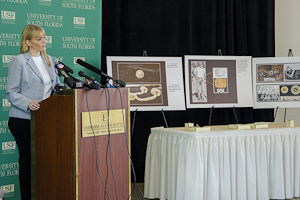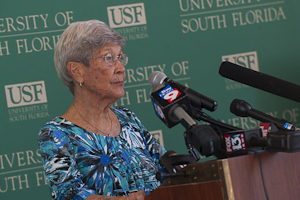Research team located 55 burials, 24 more than official records indicate
Video by Katy Hennig | USF News
TAMPA,
Fla. (Jan. 28, 2014) – Researchers
from the University of South Florida have located and excavated the remains of 55 people in a graveyard at the former Arthur
G. Dozier School for Boys – five more bodies than previous fieldwork had indicated might be there and 24 more burials than
official records indicate should be there.
The team of more than 50 people from nine agencies is
attempting to identify the remains, as well as any information on cause of
death from those buried at the now closed reform school. Using cutting-edge
scientific methods, DNA matches and advanced technology, scientists working on
the nearly two-year-old project aim to identify the bodies buried at the school
in Marianna, Florida, which has been the subject of repeated state and federal investigations
and claims of brutality and child abuse during its 100 year history.

Erin Kimmerle updates the media on the findings at Dozier.
On Tuesday, researchers from USF updated the public on the status of the research. Associate Professor Erin Kimmerle, the project’s leader, announced several key developments:
· The team recovered bones, teeth, and numerous artifacts in every one of the 55 burials. The excavation work began in September 2013 and continued through December 2013.
· Researchers will continue searching for additional unmarked burials on the school grounds, both in the areas adjacent to Boot Hill and in other areas of the school grounds. Over the next few months fieldwork will resume - including additional excavations, ground-penetrating radar analysis and the use of specially-trained K9 teams to locate burials.
· Analysis of the excavated remains is underway. Through this process, a summary report will be written for each body, including all of the information learned from skeletal and dental remains, artifacts, and burial context. Bone and tooth samples will be submitted to the University of North Texas Health Science Center for DNA testing.
· Researchers continue to work with UNT, the National Missing and Unidentified Persons System (NamUs), and the Hillsborough County Sheriff’s Office to locate possible next of kin to collect reference samples for identification. At this point, 12 surviving families of former Dozier students have been located and the Hillsborough County Sheriff’s Office is in the process of collecting DNA samples from them. Researchers still hope to collect DNA from 42 more families.

Ovell Krell is searching for her brother George Owen Smith.
A list of families for which the researchers are searching can be found here.
Anyone with information is asked to contact Hillsborough County Sheriff’s Master Detective Greg Thomas at (813) 247-8678.
“Locating 55 burials is a significant finding,
which opens up a whole new set of questions for our team,” Kimmerle said. At
this time, we know very little about the burials and the children in terms of
who specifically was buried there, their ages or ancestry, as well as the
timing and circumstances of their deaths.
“All of the analyses needed to answer these important questions are yet to be done. But it is our intention to and answer as many of these questions as possible,” she added.
The Dozier project is funded by both the State of Florida and the National Institute of Justice.
“I am very pleased that we are playing a critical role in the forensic investigations at the former Dozier School,” said Greg Ridgeway, the Acting Director of the National Institute of Justice. “The National Institute of Justice has paved the way to ever-more advanced and effective uses of forensics in solving crimes, and I am confident that the discoveries made by the USF team will not only bring resolution to these cases but will add to our knowledge about investigations of missing and unidentified persons in jurisdictions across the country.”